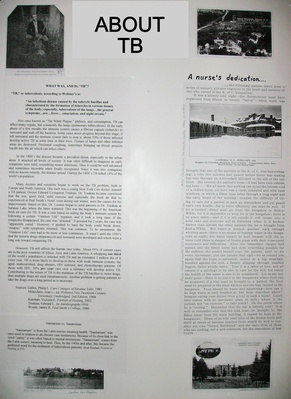About TB
 "About TB" by Pat and Tom Willis, photo of display taken 2/2009. Click on the image to enlarge the display.
"About TB" by Pat and Tom Willis, photo of display taken 2/2009. Click on the image to enlarge the display.
WHAT WAS, AND IS, “TB”?
Original Text by Pat and Tom Willis
“TB,” or tuberculosis, according to Webster’s is:“An infectious disease caused by the tubercle bacillus and characterized by the formation of tubercles in various tissues of the body; especially, tuberculosis of the lungs…the general symptoms…are…fever,…emaciation, and night sweats.”
Also once known as “The White Plague,” phthisis, and consumption, TB can affect many organs, but commonly the lungs (pulmonary tuberculosis). In the early phase of a few months the immune system causes a fibrous capsule (tubercle) to surround and wall off the bacteria. Some cases never progress beyond this stage; if left untreated and the immune system fails to stop it, about 10% of those infected develop active TB at some time in their lives. Tissues of lungs and other infested areas are destroyed. Persistent coughing, sometimes bringing up blood, projects bacilli into the air which can infect others.
In the 1800’s the disease became a prevalent threat, especially in the urban areas. It attacked all levels of society. It was often difficult to diagnose as early symptoms were mild, resembling minor infections. Thus it could be well advanced and sometimes incurable when finally recognized. Since it was also contagious with no known remedy, the disease spread. During the 1800’s TB killed 14% of the world’s population.
Many doctors and scientists began to work on the TB problem, both in Europe and North America. One such was a young New York City doctor, himself a TB patient, Doctor Edward Livingston Trudeau. Dr. Trudeau became convinced that the rest, good food, mild exercise and especially the fresh air that he experienced at Paul Smith’s Hotel, even during one winter, were the causes for his improvement. Based on this, Dr. Loomis began to send patients to Dr. Trudeau at Saranac Lake, where the latter wintered. This was the beginning of the American fresh air cure for TB. It was a cure based on aiding the body’s immune system by following a certain “Outdoor Life” regimen, and it took a long time. If the symptoms disappeared, the case was “arrested.” If arrested for 2 years, the case was “apparently cured.” However, if pushed to hard the body could break down, “relapse,” with symptoms returned. This was common. To be permanent, the “Outdoor Life” cure had to be more or less continuous. It wasn’t until the 1950’s that the miracle drugs streptomycin and isoniazid were developed and which went a long way toward conquering TB.
However, TB still affects the human race today. About 95% of current cases are in the poor countries of Africa, Asia, and Latin America. A whopping one third of the world’s population is infected with TB and an estimated 3 million die of it every year. TB is more likely to develop in those with weak immune systems: the aged, malnourished, drug abusers, HIV infected, and chemotherapy patients. Of those with HIV, 10% per year (not over a lifetime) will develop active TB. Contributing to the return of TB is the mutation of the TB bacillus to resist drugs, thus multiple drugs are used simultaneously. Another problem is getting patients to take the drugs over a long period as is necessary.
Sources:
- Gallos, Philip L. Cure Cottages of Saranac Lake 1985.
- Mckechnie, Jean L., ed. Websters New Twentieth Century Dictionary Unabridged. 2nd Edition, 1968.
- Rinehart, Victoria E. Portrait of Healing. 2002.
- Trudeau, Edward Livingston, M.D., An Autobiography. Garden City, N.Y.: Doubleday, Doran & Company, Inc., reprint 1934. Originally published 1915.
- Woods, James R. Paul Smith’s College. 1980.
Brighton History Days have been held one weekend each summer since 1994, sponsored by the Brighton Architectural Heritage Committee.



